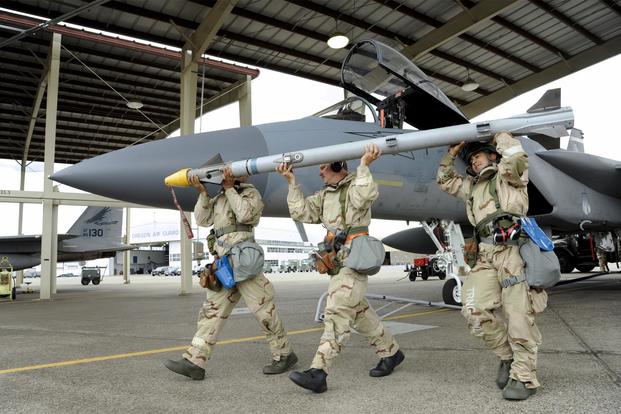Two weeks after an F-15 Eagle from Oregon experienced an in-flight emergency and had to ditch its missiles before landing, the Air National Guard is still searching for clues to what caused the emergency in the first place.
"A direct cause of the in-flight emergency is unknown at this time," 142nd Fighter Wing spokesman Steven Conklin told Military.com on Friday. The incident remains under investigation, added Maj. Samuel Lee, also of the 142nd.
The F-15C was headed out for an alert training mission when it experienced the malfunction and had to land at Portland International Airport using its emergency arrest cable, The Drive reported Feb. 20. The outlet reported that the issue possibly stemmed from the aircraft's landing gear "failing to retract."
"It is not uncommon to experience emergencies in the F-15 that require a barrier engagement," Conklin said in an email, referring to the arrest cable.
Related content:
- Why Didn't F-15s Shoot Down the Stolen Sea-Tac Airliner?
- Mechanical Issues Cause Back-to-Back F-15 Emergency Landings in Kadena
- Air Force Grounds All F-15C Fighters at Oregon Training Base
Because the Eagle had missiles on board for the alert training mission -- or scrambling at a moment's notice for an aerial intercept -- it had to clear its armament with a controlled release for the safety of the pilot, Conklin said. The Drive reported that the F-15 ditched an unspecified number of missiles into the Pacific Ocean.
"It is required for our aircrew to put the aircraft in a safe configuration to land to ensure a successful recovery of the aircraft and pilot," Conklin said.
Firing off weapons is rare in these instances, a former F-15 pilot told Military.com on background.
"The only reason to do it is if there's an unsafe gear indication, perhaps hydraulic issue," he said. In other cases, "[our] training configuration is to dump missiles anyway to preserve gas."
Standard procedure calls for safety first, meaning a plane must be clean -- without missiles -- before attempting to land on a runway, the pilot said.
"In case you're coming back and you're potentially going to be sliding on the belly of the jet [because of the emergency]; you... just want the jet to be as clean as possible," he said.
The F-15 can carry four AIM-9L/M Sidewinder air-to-air missiles and four AIM-120 advanced medium-range air-to-air missiles, or a full external load of eight AIM-120 AMRAAMs. Another common, six-missile configuration includes two Sidewinders and four AIM-120 AMRAAMs.
Last month, two F-15Cs from Kadena Air Base, Japan, had emergency mechanical issues that required both jets to conduct arrested landings.
One of the F-15s had a problem with its landing gear, and the other "experienced a hydraulic issue," Air Force Capt. Victoria Hight, spokeswoman for Pacific Air Forces, said at the time. The jets used their arresting cables to land on the same runway, but in opposite directions of one another.
Last August, the 142nd was involved in a high-profile intercept mission.
Two F-15Cs from the wing launched in response to a stolen Bombardier Q400 turboprop aircraft belonging to Alaska Airlines.
A Horizon Air employee, later identified as ground service agent Richard Russell, stole the empty aircraft Aug. 10, flying it south of Seattle before crashing into Ketron Island in Puget Sound, roughly 35 miles south of the airport.
Russell, 29, died in the crash.
-- Oriana Pawlyk can be reached at oriana.pawlyk@military.com. Follow her on Twitter at @Oriana0214.










